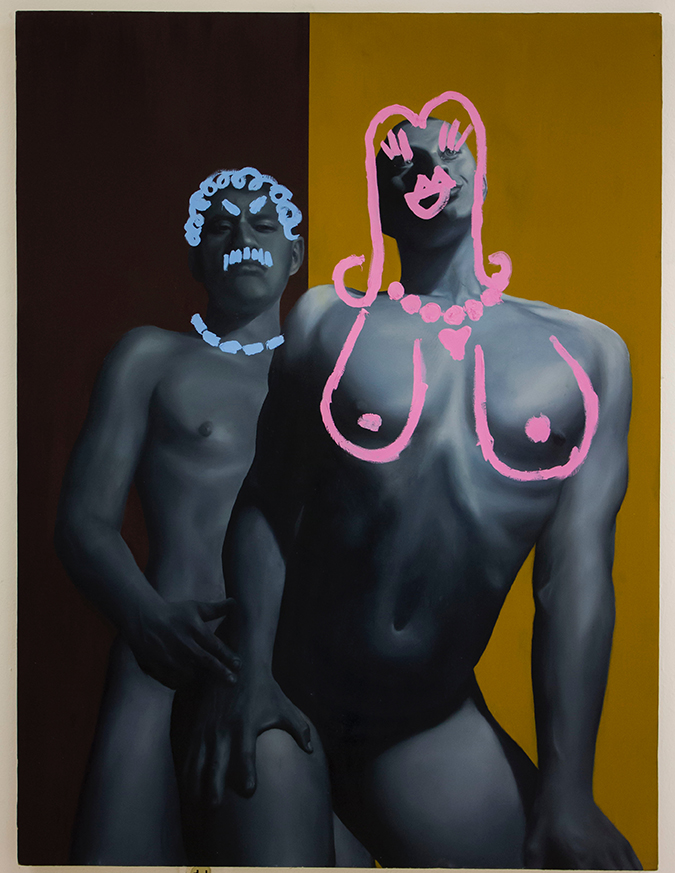If you walked into the University Art Gallery last May, you likely would have seen evocative art that touched on roles of race and gender created by art and design senior Luke Francis Austin.
In one of their most well-known pieces, “Finger Bang,” Austin depicted themself engaging in a sexual act with two versions of themself — one exhibiting stereotypically masculine roles, and one exhibiting stereotypically feminine ones.
Austin described the majority of their work as “abstract expressionist.” Abstract expressionism emphasizes the subconscious spontaneity within an artist and originated in New York after World War II. The act of creating work in a field of predominantly white men is a form of rebellion for Austin, who is biracial and identifies as non-binary.
“I think it’s important to depict myself as an act of rebellion against traditional representation,” Austin said.

Austin has been involved in the Art & Design Department for less than a year after transferring from the Graphic Communication Department. They said that as of now, they are the only African American person in the Studio Art program at Cal Poly.
“Existing in a historically white space and in white spaces in general is very interesting to me, and oil painting is historically a white man’s medium,” Austin said. “I think it’s interesting to interject my body into that tradition and see how it manifests.”
Because Austin said they do not feel they fit within the binary system, they chose gray as their skin complexion in a large majority of their work.
“I depict my figures in gray scale to de-contextualize them,” Austin said. “In ‘Finger Bang,’ with the two versions of myself having sex, I wanted to talk about colorism and the preference of dark skin and light skin, and light skin being seen as a more feminine, desirable trait, and darker skin being seen as a more aggressive, less desirable trait. I removed the color and talk about it and pure color without race involved, just to objectively talk about the value of the color of our skin.”
Luke is also co-president of the revived Studio Art Club. After a 10-year hiatus, the club is alive again, and they said both the studio art community and club are growing significantly. Luke said they are interested in what gets to be depicted and the meaning of being represented.
When the photo surfaced of former Lambda Chi Alpha member Kyler Watkins in blackface last April, Austin stood up in front of their studio art classroom and talked about the power a visual act has on a community.

“To make an image is a very powerful act, and to understand the visual language is very important,” Austin said. “It’s such an important skill to have and after the blackface incident, I got up in front of my class. I was like, ‘Teacher, I need to make an announcement.’ I went off and was like, ‘This is an act of visual racism, it’s such a visually aggressive act.’ I just talked about how to include people, to have people be seen in an image in an art piece, and to create discourse around this topic is such a powerful thing.”
Austin said they believe art has the potential to make a positive impact on campus climate because it can evoke emotions and inspire change. They said the act of creating pieces around their experience with race and gender is cathartic to them, but that they also aim to create conversation.
“I think that the art program and art around campus can inspire people and create discourse about topics that need to be talked about, that are just kind of tossed to the wayside,” Austin said. “I think it has so much potential to create so much change around campus.”
Austin said their piece “In My mother’s Bureau” is an image of them in a storefront window as a mannequin, wearing a wig. When they were young, they said they remember trying on different makeup and clothing in their mother’s room. Although Austin identifies more with womanhood than manhood, they said that as a young person depicted in the painting, they struggled to figure out where they belonged in the spectrum of gender.
“Something that I’ve kind of asked myself growing up and being half Black and half white, my parents would be like, ‘You’re gray,’ in the middle, you know, right? I always felt like this gray blob of nothingness that had nothing really attached to it. And so, I think a question to ask myself is, ‘What is it like to be gray in a black and white world?’ What does it mean to be something in the middle in a binary-oriented world?”

